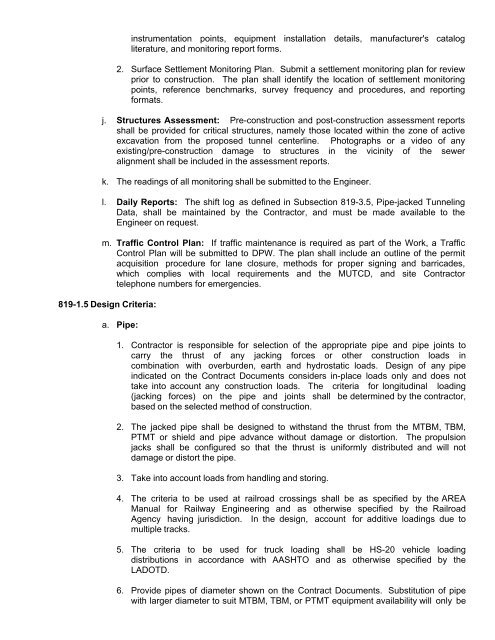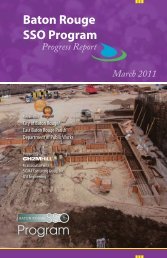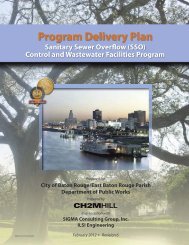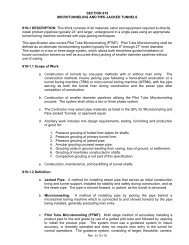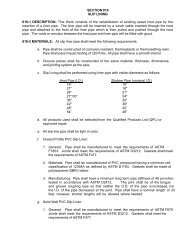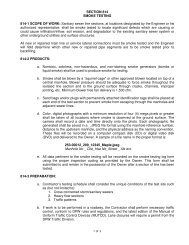SECTION 819 MICROTUNNELING AND PIPE-JACKED TUNNELS ...
SECTION 819 MICROTUNNELING AND PIPE-JACKED TUNNELS ...
SECTION 819 MICROTUNNELING AND PIPE-JACKED TUNNELS ...
- No tags were found...
Create successful ePaper yourself
Turn your PDF publications into a flip-book with our unique Google optimized e-Paper software.
instrumentation points, equipment installation details, manufacturer's catalog<br />
literature, and monitoring report forms.<br />
2. Surface Settlement Monitoring Plan. Submit a settlement monitoring plan for review<br />
prior to construction. The plan shall identify the location of settlement monitoring<br />
points, reference benchmarks, survey frequency and procedures, and reporting<br />
formats.<br />
j. Structures Assessment: Pre-construction and post-construction assessment reports<br />
shall be provided for critical structures, namely those located within the zone of active<br />
excavation from the proposed tunnel centerline. Photographs or a video of any<br />
existing/pre-construction damage to structures in the vicinity of the sewer<br />
alignment shall be included in the assessment reports.<br />
k. The readings of all monitoring shall be submitted to the Engineer.<br />
l. Daily Reports: The shift log as defined in Subsection <strong>819</strong>-3.5, Pipe-jacked Tunneling<br />
Data, shall be maintained by the Contractor, and must be made available to the<br />
Engineer on request.<br />
m. Traffic Control Plan: If traffic maintenance is required as part of the Work, a Traffic<br />
Control Plan will be submitted to DPW. The plan shall include an outline of the permit<br />
acquisition procedure for lane closure, methods for proper signing and barricades,<br />
which complies with local requirements and the MUTCD, and site Contractor<br />
telephone numbers for emergencies.<br />
<strong>819</strong>-1.5 Design Criteria:<br />
a. Pipe:<br />
1. Contractor is responsible for selection of the appropriate pipe and pipe joints to<br />
carry the thrust of any jacking forces or other construction loads in<br />
combination with overburden, earth and hydrostatic loads. Design of any pipe<br />
indicated on the Contract Documents considers in-place loads only and does not<br />
take into account any construction loads. The criteria for longitudinal loading<br />
(jacking forces) on the pipe and joints shall be determined by the contractor,<br />
based on the selected method of construction.<br />
2. The jacked pipe shall be designed to withstand the thrust from the MTBM, TBM,<br />
PTMT or shield and pipe advance without damage or distortion. The propulsion<br />
jacks shall be configured so that the thrust is uniformly distributed and will not<br />
damage or distort the pipe.<br />
3. Take into account loads from handling and storing.<br />
4. The criteria to be used at railroad crossings shall be as specified by the AREA<br />
Manual for Railway Engineering and as otherwise specified by the Railroad<br />
Agency having jurisdiction. In the design, account for additive loadings due to<br />
multiple tracks.<br />
5. The criteria to be used for truck loading shall be HS-20 vehicle loading<br />
distributions in accordance with AASHTO and as otherwise specified by the<br />
LADOTD.<br />
6. Provide pipes of diameter shown on the Contract Documents. Substitution of pipe<br />
with larger diameter to suit MTBM, TBM, or PTMT equipment availability will only be


